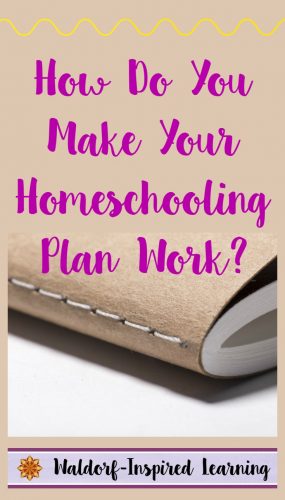One of the questions I hear the most from Waldorf homeschoolers is “how do I find time for planning during the school year?”
Believe me, I have struggled with this one as well. Do we set aside some time on Sundays and wind up missing out on activities with the family? Stay up late and compromise our sleep that we need so much? Do we just wing it during lessons? Or skip lessons altogether because we have nothing planned?
I’ve tried them all! And what I want to share with you is a simple process for planning your year and keeping the lessons going.
 Now, hopefully you’ve gotten a start on these plans already if you’re starting a new homeschool year shortly! But I know how things can get off track some years, and I also know that it helps to have the whole picture in mind. So let’s imagine this from the beginning.
Now, hopefully you’ve gotten a start on these plans already if you’re starting a new homeschool year shortly! But I know how things can get off track some years, and I also know that it helps to have the whole picture in mind. So let’s imagine this from the beginning.
Start with the bird’s eye view. The big paper plan. This is where you map out your main lesson blocks for the year.
Take a large sheet of drawing paper and fold it in half, in half again, and then into thirds to get 12 blocks. Then label each block with a month. The very simplest way to plan for main lesson blocks in Waldorf homeschooling is to plan for a block each month. Be sure to write in holidays and other time off so you can get an idea of how many days each block will actually be.
Next step is to begin planning those first few blocks. I like to plan for about three blocks at a time and create an outline of a plan for these. This also helps to plan by the season: three in fall, three in winter, three in spring.
Now this is where so many people get hung up. How do we begin to flesh out the plans? But also leave things flexible enough for the changes and surprises and spontaneous things life will bring our way?
First, I find it helpful to begin with the concept of the lively arts. Teaching in main lesson blocks plus with the lively arts is what makes Waldorf unique. You can have a look here at my article on The Seven Lively Arts for lots of ideas on how to weave the arts into everything you do.
Next, how do you keep the plan moving forward? In short, I suggest you create a weekly planning rhythm that works for you. And chunk it down so you don’t have to do the planning all at once.
This is the ideal. Believe me, I have spent plenty of Sundays in the past 28 years doing some last minute planning! But if you create a rhythm for yourself and stick with it, you will find that homeschooling with Waldorf doesn’t have to be as hard or as complicated as we sometimes make it out to be!
You might be interested in learning more about my group coaching program, Plan It Out. In just 3 weeks, together with others on the Waldorf homeschooling journey, you’ll create a concrete plan for your upcoming year or blocks. Learn more about Plan it Out here.
Here’s one possible weekly planning rhythm:
- Thursday evenings: choose your stories for next week (if you homeschool 4 days a week, and follow the two-day rhythm for lessons, you will need two stories)
- Friday: choose the songs and verses
- Saturday: choose the artistic activity (drawing or painting or modeling) & check supplies
- Sunday: review it all and get any necessary supplies
You can tweak this any way that suits your needs. But creating a simple weekly rhythm like this can really increase your chances of keeping your planning going throughout the school year.
How do you make your homeschooling plan work?


